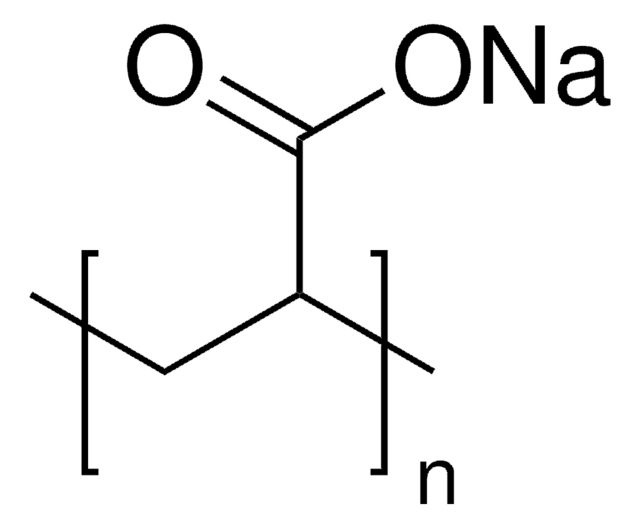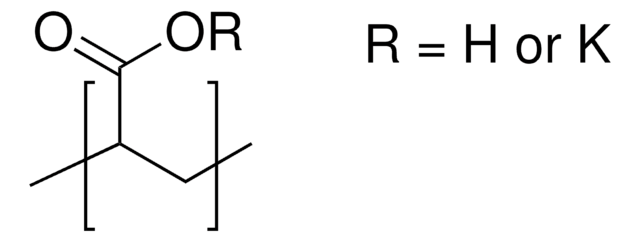About This Item
Recommended Products
crosslinking
~0.1 % cross-linked
Quality Level
mol wt
average Mv ~3,000,000
viscosity
30,000-40,000 cP
transition temp
Tg 106 °C
InChI
1S/C3H4O2.Na/c1-2-3(4)5;/h2H,1H2,(H,4,5);/q;+1/p-1
InChI key
NNMHYFLPFNGQFZ-UHFFFAOYSA-M
Looking for similar products? Visit Product Comparison Guide
Related Categories
Application
- IR and Raman investigation of some poly(acrylic) acid gels in aqueous and neutralized state: This study explores the modification of local polymeric conformation of poly(acrylic) acid (PAA), induced by hydration and neutralization with triethanolamine, using IR and Raman spectroscopy. (M Todica et al., 2015).
- Phase Behavior of Aqueous Poly(acrylic acid-g-TEMPO): Research on poly(acrylic acid) grafted with TEMPO moieties, focusing on phase separation behavior over different pH ranges, which could be relevant for creating responsive materials. (Q Fu et al., 2016).
- Synthesis and characterization of poly(glyceric acid carbonate): a degradable analogue of poly(acrylic acid): This article presents a degradable analogue to poly(acrylic acid) and compares the properties of hydrogels prepared from this new polymer with those from PAA, relevant for biomedical applications. (H Zhang et al., 2015).
- Mechanically stable thermally crosslinked poly(acrylic acid)/reduced graphene oxide aerogels: Study on enhancing the mechanical integrity of reduced graphene oxide aerogels by intermixing with thermally cross-linkable PAA, pertinent to material science. (H Ha et al., 2015).
- Polyacrylic acid polymers hydrogels intended for topical drug delivery: preparation and characterization: Investigates the bioadhesiveness of polyacrylic acid polymers in hydrogels, emphasizing their potential in designing topical drug delivery systems. (G Calixto et al., 2015).
Signal Word
Danger
Hazard Statements
Precautionary Statements
Hazard Classifications
Carc. 1A - Muta. 1B
Storage Class Code
6.1C - Combustible acute toxic Cat.3 / toxic compounds or compounds which causing chronic effects
WGK
WGK 3
Flash Point(F)
Not applicable
Flash Point(C)
Not applicable
Choose from one of the most recent versions:
Already Own This Product?
Find documentation for the products that you have recently purchased in the Document Library.
Customers Also Viewed
Articles
Magnetic-plasmonic nanoparticles offer the combined benefits of both a magnetic probe as well as additional imaging modes usually associated with noble metal nanoparticles. Professor Shinya Maenosono (Japan Advanced Institute of Science and Technology) explores the synthesis, characterization, and proof-of-concept application of Ag/FeCo/Ag core/shell/shell magnetic-plasmonic nanobeads for imaging and isolation of cellular organelles (autophagosomes of COS-1 cells).
Our team of scientists has experience in all areas of research including Life Science, Material Science, Chemical Synthesis, Chromatography, Analytical and many others.
Contact Technical Service



